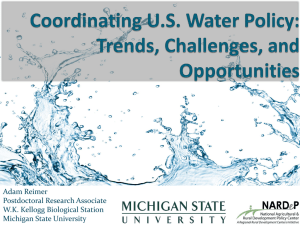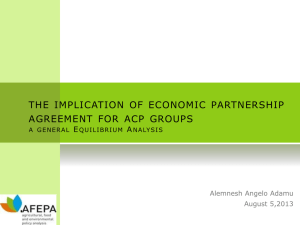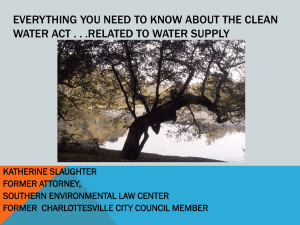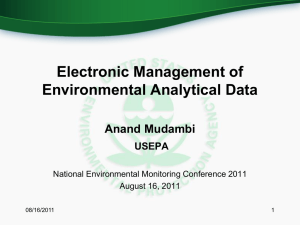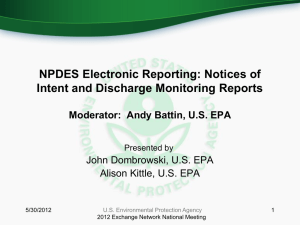Proposed e-Reporting
advertisement
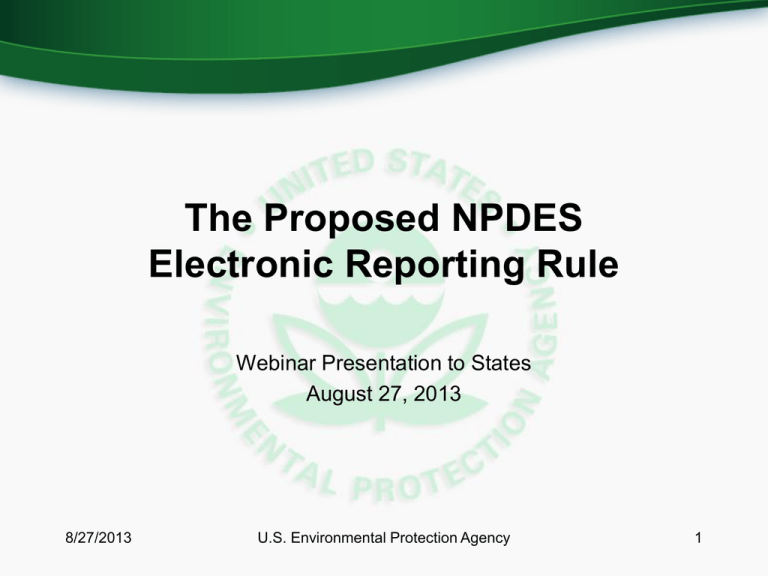
The Proposed NPDES Electronic Reporting Rule Webinar Presentation to States August 27, 2013 8/27/2013 U.S. Environmental Protection Agency 1 Webinar Logistics NOTE: The official means for providing public comments to EPA on the proposed rule is through the docket. The specific process for submitting comments are on the last slide. All webinar questions or comments may not be included in the docket. • Phone: *6 Mute • Questions: • #6 Unmute Webinar Help: 1-866-411-4372 select 3 then 5 8/9/2013 U.S. Environmental Protection Agency 2 Agenda 8/27/2013 • Goals of the Proposed Rule • Key Changes as a Result of OMB Review • Detailed Explanation of What Data • Implementation of the Proposed Rule • Elimination of Some State Reporting to EPA • Overview of the Economic Analysis • Key Items for Comment • Next Steps/Discussion U.S. Environmental Protection Agency 3 Goals of the Proposed Rule 8/27/2013 U.S. Environmental Protection Agency 4 Goals Of This Proposed Rule This rule will help EPA and states clean up the nation’s waters, by: • Bring the NPDES Program into the 21st Century by shifting from paper to electronic reporting. Proposed rule establishes no new reporting requirements • Save money and time for the regulated community and for states (reduce data entry time, improve accuracy) • Improves transparency and frees up resources to focus on the most important problems • Uses technology to obtain more accurate, timely, and complete information about the NPDES program 8/27/2013 U.S. Environmental Protection Agency 5 NPDES-Regulated Facilities Pretreatment Programs - Approved, Non-Majors with 1,600 Individual Permits, 39,000 Municipal Separate Stormwater Sewer Systems, 7,300 Separate Sewer Systems - including satellite systems, 20,000 Biosolids Generators, 16,500 CAFOs (75% may need permits), 19,000 Combined Sewer Systems, 800 Majors, 6,700 Industrial Stormwater, 89,000 General Permits 71,000 (estimate includes duplication of facilities- e.g. ~4,000 CAFOs covered by GPs) Construction Stormwater, 200,000 . Note: This graph covers all discharge sources except for significant industrial users not under an Approved Pretreatment Program and dischargers operating under general permits for discharges from vessels and discharges from pesticide applicators. 8/27/2013 U.S. Environmental Protection Agency 6 Reporting Burden On States And Regulated Entities Is Reduced • • • • Obtain required information directly from the source where data is generated: from permittees in most cases; from the states/EPA where they are the unique source of program implementation data such as permits, inspections, violation determinations, and enforcement actions. Reduce burden of existing paper-based reporting from regulated facilities by requiring electronic data submissions; results in overall cost savings for those regulated. Significant reduction in reporting burden for states due to DMR reporting from facilities; also results in significant cost savings for states. Propose to eliminate specific existing state reporting requirements: – Annual Noncompliance Report (for non-majors) (40 CFR 123.45) – Quarterly Noncompliance Report (for majors) (40 CFR 123.45) – Semi-Annual Statistical Summary Report (for majors) (40 CFR 123.45) 8/27/2013 U.S. Environmental Protection Agency 7 Key Changes as a Result of OMB Review 8/27/2013 U.S. Environmental Protection Agency 8 Key Changes • Supplemental Notice – If significant changes are needed to address comments, EPA will publish a supplemental notice with its response to public comments, prior to issuance of a final rule. Will especially look at the following areas: • Governance of the data; • Implementation of the rule; and • Specific information included in the rule. • CAFO Notices of Intent (NOIs) Are Now In Phase II of the Rule Implementation Plan – Previously had been included in Phase I of the implementation plan. 8/27/2013 U.S. Environmental Protection Agency 9 What Data Does the Proposed Rule Seek? 8/27/2013 U.S. Environmental Protection Agency 10 Minimum Set of Federally Reported Data • Appendix A to the proposed rule (40 CFR 127) identifies the specific data (name, description, regulatory/policy citation, data group) that are the minimum set of Federally reported data. • States can require more data from NPDES regulated entities. o • If EPA is the initial recipient of these state data, then EPA will automatically transmit these data to the applicable state data system. EPA is proposing to identify this minimum set of data to be reported electronically to ensure that there is consistent and complete reporting nationwide, and to expedite the collection and processing of the data, thereby making it more accurate and timely. 8/27/2013 U.S. Environmental Protection Agency 11 11 Key Concepts • Proposed regulation will require that NPDES permittees electronically submit most of the required NPDES data (e.g., DMRs, NOIs, program reports) directly to states or EPA. – This information will need to be submitted to EPA in a nationally-consistent manner. – These data submissions would meet EPA’s current signatory and chain of custody requirements in Parts 3 (CROMERR) and 122 (NPDES Regs). • Permittee electronic submissions will be supplemented by authorized state electronic submission: – Basic facility and permit data; and – Data originating from the states (e.g., inspections, violation determinations, enforcement actions). 8/27/2013 U.S. Environmental Protection Agency 12 NPDES Information Sought Under This Rule Inspections** and single event violations** *Data supplied by permittees **Data supplied by states & EPA ***Data calculated by data system Program reports* and violations** DMR information* and effluent violations** Basic Facility* Data uses 8/27/2013 Permit information (including permit applications*, eNOI*, effluent limits** and outfalls*) Identify regulated universe, applicable requirements, and environmental significance Enforcement actions** Determine and document compliance status U.S. Environmental Protection Agency Document enforcement response 13 More Efficient Existing Data Submissions Existing NPDES Program Reporting Data from NPDES Permittees Discharge Monitoring Reports (DMRs) Part 122.41(l)(4)(i) General Permit Reports (NOI, NOT, NECs, LEWs) Part 122 Biosolids Annual Program Reports Part 503 CAFO Annual Program Reports MS4 Program Reports Part 122.42(e)(4) Part 122.34(g)(3), 122.42(c) Pretreatment Program Annual Reports Industrial User Compliance Reports in Municipalities Without Approved Pretreatment Programs – When EPA or State is Control Authority Sewer Overflow Event Reports (CSOs, SSOs, Bypass events) Data from States 40 CFR Part 403.12(i) Part 403.12(e) & (h) Part 122.41(l)(6), (7), & (m) Require electronic reporting by NPDES-authorized states, territories, tribes, and Regions of program implementation information (permits, inspections, violations, and enforcement actions) Part 123.41 & 123.43 Eliminate requirements for the annual state biosolids annual report, semi-annual statistical summary report, phase out state burden for ANCR and QNCR submissions, and rename and modify terms defining Category I and Category II noncompliance to reflect the new data sources Part 123.45 8/27/2013 U.S. Environmental Protection Agency 14 Appendix A Data • EPA worked from existing regulatory requirements to create the list of the minimum set of data that must be submitted by states and permittees to maximize impact of e-reporting. • These data are part of the proposed rule: Appendix A to 40 CFR 127. • The proposed rule makes clear what data are required for each report (e.g., DMRs, NOIs, program reports) and who submits these reports. • The proposed rule would also require timely data sharing between EPA and states for these data listed in Appendix A. 8/27/2013 U.S. Environmental Protection Agency 15 Appendix A Data (cont.) • The list of data is not applicable to all facilities (e.g., POTWs do not need to report CAFO data): – • Some are applicable only to a small portion of the NPDES universe (e.g., there are approximately 4 POTWs that have pretreatment removal credits authority). The need to update and report data depends on the data source (e.g., data derived from the NPDES permit application will need to be updated and reported to EPA at each permit renewal, usually a 5-year interval). 8/27/2013 U.S. Environmental Protection Agency 16 Discharge Monitoring Reports (DMRs) • These reports comprise the largest source of NPDES program data shared between permittees, states, and EPA. • Under the proposed rule EPA would require all DMRs (major and non-majors) to be electronically submitted to states or EPA by permittees one year after the effective date of the rule (Phase 1). • Electronic submissions by NPDES permittees must be in accordance with 40 CFR 122.41(l)(4), which will reference the need for these submissions to be compliant with 40 CFR Parts 3 (CROMERR) and 127 (NPDES Electronic Reporting Rule). 8/27/2013 U.S. Environmental Protection Agency 17 General Permits • General permits can be a cost-effective option for agencies because of the large number of facilities that can be covered under a single permit. • Though 80% of NPDES permitted facilities are regulated by general permits, there is limited national data for general permit covered facilities. • The proposed rule would require states to input general permit conditions and limits once per renewal, then require facilities to submit e-NOI and other general permit forms electronically. These general permit forms can be linked to the state general permit conditions in the database. • Under the proposed rule all general permit reports (major and non-majors) would be electronically submitted by NPDES permittees to states or EPA one year after the effective date of the rule (all EPA issued permits) or two years after the effective date of rule (Phase 2 – state issued permits). 8/27/2013 U.S. Environmental Protection Agency 18 General Permit Reports The general permit reports that will be electronically submitted to states or EPA include: • • • • 8/27/2013 Notice of Intent (NOI) to discharge: This is the initial report seeking coverage under a general permit (40 CFR 122.28(b)(2)(i) and (ii)); Notice of Termination (NOT): A request by the permittee to terminate their coverage under an existing permit (40 CFR 124.5); No Exposure Certifications (NEC): A certification from a facility indicating that coverage under an existing industrial stormwater permit is not necessary due to certain facility-specific conditions (40 CFR 122.26(g)(1) and (4)); and Low Erosivity Waivers (LEW): A certification from a facility indicating that coverage under an existing construction stormwater permit is not necessary due to certain facility-specific conditions (40 CFR 122.26(b)(15)). U.S. Environmental Protection Agency 19 Biosolids Annual Program Reports • EPA has established a protective regulatory framework to manage the use and disposal of biosolids at 40 CFR Part 503. These are minimum requirements for the safe management of biosolids. • EPA biosolids regulations require annual reports from POTWs with a design flow rate equal to or greater than one million gallons per day, POTWs that serve 10,000 people, and Class I sewage sludge management facilities. • Under the proposed rule EPA would require all biosolids annual program reports to be electronically submitted to states or EPA two years after the effective date of the rule (Phase 2). 8/27/2013 U.S. Environmental Protection Agency 20 CAFO Annual Program Reports • EPA and states need to collect accurate and timely CAFO information to ensure that manure and wastewater from CAFOs are properly managed. • NPDES-permitted CAFOs are required to submit an annual report to the State Director or Regional Administrator pursuant to 40 CFR 122.42(e)(4). • Under the proposed rule EPA would require all CAFO annual program reports to be electronically submitted by NPDES permittees to states or EPA two years after the effective date of the rule (Phase 2). 8/27/2013 U.S. Environmental Protection Agency 21 MS4 Program Reports • EPA issues NPDES permits to municipal separate storm sewer systems (MS4s) which require MS4s to reduce pollutants in storm water discharges and which prohibit illicit discharges. • EPA regulations require MS4 operators to submit program reports documenting their actions to control municipal stormwater. – Large and medium MS4 operators submit annual reports [40 CFR 122.42(c)] – Small MS4 operators submit reports twice during each permit cycle [40 CFR 122.34(g)(3)] • Under the proposed rule EPA would require MS4 program reports to be electronically submitted by NPDES permittees to states or EPA two years after the effective date of the rule (Phase 2). 8/27/2013 U.S. Environmental Protection Agency 22 Pretreatment Annual Program Reports • EPA has authorized 36 states to enforce the NPDES pretreatment program, who can further authorize pretreatment program authority to local governments (currently 1,600 local pretreatment programs overseeing ~20,000 significant industrial users (SIUs). • EPA regulations at 40 CFR 403.12(i) require approved pretreatment programs to submit an annual report to their Approval Authority • Under the proposed rule EPA would require all pretreatment annual program reports to be electronically submitted to states or EPA two years after the effective date of the rule (Phase 2). 8/27/2013 U.S. Environmental Protection Agency 23 Industrial User Compliance Reports in Municipalities Without Approved Pretreatment Programs with EPA or State as Control Authority • In the absence of approved local pretreatment programs, EPA or the state functions as the Control Authority to oversee SIUs and categorical industrial users (CIUs). • SIU/CIUs in municipalities without approved pretreatment programs would electronically submit the following biannual reports to states or EPA: – Periodic reports on continued compliance for CIUs [40 CFR 403.12(e)] – Periodic reports on continued compliance for Non-CIUs [40 CFR 403.12(h)] • The proposed rule requires these SIU/CIUs to submit these reports to states/EPA two years after the effective date of the rule (Phase 2). 8/27/2013 U.S. Environmental Protection Agency 24 Sewer Overflow Event Reports [CSO, SSO, Bypass Events] • EPA estimates that the annual CSO and SSO discharge volumes of untreated wastewater at 850 billion and three to ten billion gallons per year, respectively. • POTWs must report sewer overflow events as part of the “standard conditions” applicable to all NPDES permits (see 40 CFR 122.41(l)(6) and (7), and (m)(3)) or the CSO Control Policy. • Under the proposed rule EPA would require all sewer overflow event reports to be electronically submitted by NPDES permittees to states or EPA two years after the effective date of the rule (Phase 2). 8/27/2013 U.S. Environmental Protection Agency 25 Implementation of the Proposed Rule 8/27/2013 U.S. Environmental Protection Agency 26 Waivers • EPA recognizes that electronic reporting could be problematic for certain facilities, particularly those located in remote rural areas. – Although 65% of American adults use high-speed Internet connections at home, only 50% of rural residents have broadband. – One in ten rural non-users of broadband say they cannot get broadband where they live, more than twice the national average. • Taking into account the limitations of broadband availability and technological capabilities, EPA is considering providing a temporary exception to the electronic reporting requirements for facilities lacking broadband capability or high-speed Internet access. 8/27/2013 U.S. Environmental Protection Agency 27 Converting To E-Reporting In A Timely Manner • States will have two years after the effective date of the rule to implement ereporting in their permits. • Where states have not been able to meet certain criteria, EPA will use its CWA Section 308 authority to obtain required information from permittees. • Under this plan, EPA will have data for the required regulatory universe three years after the effective date of the rule. • EPA considered using the permit renewal cycle (5-years) after the 2 years states have to modify their regulatory and permitting programs, but this scenario would not provide data for the required regulatory universe until 2020 at the earliest. 8/27/2013 U.S. Environmental Protection Agency 28 Working with States Before & During Implementation States with an eDMR/NetDMR System or planned (n=48) • Work with states to bring their adoption rates above 90% through: – Individualized market plans and assistance; – Training and assistance for states to implement NetDMR (n=19); and – Identify next steps necessary prior to full implementation of the rule. States without existing or planned eDMR/NetDMR System (n=2) • • Work with states to identify what it would take for them to develop their own eDMR system or adopt NetDMR. Provide technical and financial assistance to help states implement an approach to build electronic tools prior to full implementation of the rule. Identify financial assistance to states to implement e-reporting. 8/27/2013 U.S. Environmental Protection Agency 29 Two-Phase Implementation Approach • Phase 1 Data: EPA and states would electronically receive: o Basic facility and permit information as well as inspections, violation determinations, and enforcement actions data from states; o DMR information from facilities; and o Information from general permit covered facilities [e.g., notices of intent to discharge (NOIs), notices of termination (NOT), no exposure certifications (NECs), and low erosivity waivers (LEWs)] for Federallyissued general permits. • Phase 2 Data: In addition to Phase 1 data, EPA and states would receive: o Information from general permit covered facilities for other state-issued general permits (see above); and o Program reports from all facilities. 8/27/2013 U.S. Environmental Protection Agency 30 30 Main Factors Driving EPA’s Implementation Approach • Technology for electronic reporting is currently available. • Agency’s renewed focus on using NPDES program data to focus on most significant sources and determining performance of facilities and government. • Government responsibility to make data publicly accessible; shown to drive better performance and accelerate the many benefits. 8/27/2013 U.S. Environmental Protection Agency 31 Benefits of EPA’s Proposed Implementation Approach • The benefits of this proposal include: – – – – Accelerated resource savings Reduced data entry burden and error resolution burden; Reduced effort in responding to public requests for data; Consistent requirements for electronic reporting across all facilities and states; and – More timely access to NPDES program data in an electronic format for EPA, states, regulated entities, and the public. 8/27/2013 U.S. Environmental Protection Agency 32 What Does This Implementation Approach Mean for States? • What does a state need to do to avoid EPA using its CWA §308 authority to request data directly from facilities in their state? – Operate or utilize a data system for all of the proposed data. – Make available compliant state or EPA reporting tools. – No barriers in state statutes/regs/permits for electronic reporting (e.g., may allow for voluntary e-reporting). – Exceed the 90% participation threshold (by data group). • States may also elect to begin minor modifications to incorporate ereporting requirements into existing NPDES Permits. – • As an example, Michigan used a blanket permit attachment to incorporate their electronic reporting requirements into many permits through one collective action. Facilities in states that don’t meet the criteria within two years of the effective date of the rule will be required to report to the state and EPA. 8/27/2013 U.S. Environmental Protection Agency 33 NPDES E-Rule Implementation • Initial Activities: o EPA and states coordinate on data exchange (CWA §308). o States identify the data groups for they are the initial recipient of data. o EPA and states register and train permittees for new CWA §308 and e-Rule and requirements for Phase 1 data. o States begin to change their state implementation regulations and procedures to incorporate e-Rule requirements (NPDES program implementation). o Where possible states perform minor modifications to require ereporting compliant with EPA’s e-reporting requirements in existing permits. o All new/re-issued permits will require compliant e-reporting. o Where e-reporting is already taking place, boost permittee participation past 90% (by data group). 8/27/2013 U.S. Environmental Protection Agency 34 NPDES E-Rule Implementation • One year after the effective date of the rule: o Permittees will report Phase 1 data to states where state e-reporting tools/systems/participation rates are above 90% (state sends to EPA). – The 90% participant rate calculation excludes facilities under a temporary waiver. – Participation rate calculations will be made by data group. o Where states do not meet the readiness criteria, EPA collects Phase 1 data directly from permittees (by data group) until the state meets the criteria. This may result in double reporting – paper-copy to states, electronic reporting to EPA. o EPA and states register and train permittees for new CWA §308 and eRule and requirements for Phase 2 data. 8/27/2013 U.S. Environmental Protection Agency 35 NPDES E-Rule Implementation • Two years after the effective date of the rule: o Permittees will report Phase 2 data to states where state e-reporting tools/systems/participation rates are above 90% (state sends to EPA). – The 90% participant rate calculation excludes facilities under a temporary waiver. – Participation rate calculations will be made by data group. o Where states do not meet the readiness criteria, EPA collects Phase 2 data directly from permittees (by data group) until the state meets the criteria. This may result in double reporting – paper-copy to states, electronic reporting to EPA. 8/27/2013 U.S. Environmental Protection Agency 36 CWA 308 Authority as a Backstop • Section 308 of the CWA grants EPA broad authority to require regulated entities to maintain records, make reports, perform monitoring and sampling, and provide this information to EPA as is necessary. • EPA, in consultation with states, will make determinations by state and data group (e.g., DMRs, program reports) on whether to exclude facilities from CWA §308 reporting (i.e., facilities would e-report to their state). • Possible use of CWA §308 authority will be implemented in two phases with specific dates specified in the rule: – One year after the effective date of the rule for Phase 1 data (e.g., DMRs, NOIs for Federal issued permits); and – Two years after the effective date of the rule for Phase 2 data (all remaining program NPDES data including program reports and general permits). 8/27/2013 U.S. Environmental Protection Agency 37 State Readiness Criteria • States must meet the three conditions of the “State Readiness Criteria” to avoid regulated entities from this Section 308 reporting; o Permittees submit timely, accurate, complete, and national consistent NPDES data using approved state or third-party electronic reporting tools (evaluated by state and by data group with the acceptance criteria of 90%); and o The state or third-party electronic reporting tools used by the permittee meet all of the minimum Federal reporting requirements for 40 CFR 3 (CROMERR) and 40 CFR 127 (NPDES Electronic Reporting Rule); and o EPA lists the state as the initial recipients for electronic NPDES information from NPDES regulated entities. These designations are also made separately for each NPDES data group. 8/27/2013 U.S. Environmental Protection Agency 38 38 State Readiness Criteria • EPA will make its decisions on who is subject to the CWA Section 308 request by state and by data group. These data groups are: o o o o o o o o • Discharge Monitoring Report; General Permit Reports [NOI, NOT, NECs, LEWs]; Biosolids Annual Program Report; Concentrated Animal Feeding Operation (CAFO) Annual Program Reports; Municipal Separate Storm Sewer System (MS4) Program Report; Pretreatment Program Annual Report; Industrial User Compliance Reports in Municipalities Without Approved Pretreatment Programs – When EPA or State is Control Authority; and Sewer Overflow Event Reports [CSO, SSO, Bypass]. For example, if more than 90% of NPDES permittees in a particular state that are required to submit DMRs do so in accordance with the State Readiness Criteria, then all NPDES permittees in that particular state that are required to submit DMRs would not need to electronically report to EPA under the proposed CWA section 308 request. 8/27/2013 U.S. Environmental Protection Agency 39 39 Identifying the Initial Recipient of Electronically Reported NPDES Data • The proposed rule identifies procedures for identifying the initial recipient of e-reported NPDES data by state and by data group. States should: o o o • Identify the specific NPDES data groups that they wish to accept as the initial recipient; Describe how their data system with be compliant with 40 CFR 3 (CROMERR) and 127 (NPDES Electronic Reporting Rule); and Date or dates when the state, territory or tribe will be ready for accepting NPDES information from NPDES regulated entities in a manner compliant with 40 CFR 3 and 127. EPA will publish on its website and in the Federal Register a listing of the initial recipients for electronic NPDES information from NPDES regulated entities by State and by NPDES data group. 8/27/2013 U.S. Environmental Protection Agency 40 40 Identifying the Initial Recipient of Electronically Reported NPDES Data • The initial recipient listing will inform NPDES regulated entities where they should send their NPDES electronic data submissions and the due date for these NPDES electronic data submissions. • EPA will update this listing on its website and in the Federal Register if a state, territory or tribe gains authorization status to administer a NPDES program and is also approved by EPA to be the initial recipient of NPDES electronic data submissions for that program. • EPA and states will share NPDES program data using the Exchange Network (regardless of who is the initial recipient of electronic data submissions). If EPA is the initial recipient, EPA will share data with states through EN/CDX. • The proposed rule also adds a new standard permit condition that will require NPDES permittees to identify the initial recipient for their electronic submissions. 8/27/2013 U.S. Environmental Protection Agency 41 41 Implementation Considerations • EPA HQ recognizes that any implementation plan for this rule would be contingent upon: – ICIS-NPDES batch capability; – Appropriate modifications to ICIS-NPDES and state systems; – Electronic reporting tools to collect the required data; • However, the rule does not require states to develop their own electronic reporting tools. – And, establish a registration and electronic signature process. • EPA will work closely with state to maximize preparedness for ereporting and minimizing the impact of the CWA §308 approach. 8/27/2013 U.S. Environmental Protection Agency 42 Elimination of Some State Reporting to EPA 8/27/2013 U.S. Environmental Protection Agency 43 Changes to Noncompliance Reporting and Elimination of Reporting Burden • This rule provides the opportunity to eliminate the reporting requirements for the QNCR, ANCR, and the semi-annual statistical summary report (40 CFR 123.45), and the biosolids annual report from states (40 CFR 501.21). • By relying on the broader range of e-reported data and small modifications to the categorization of violations, EPA can produce the equivalent of these reports through ICIS-NPDES. This will provide: – – – – A more accurate and comprehensive report of known violations across the NPDES universe; Improved oversight and better analyses and tracking of violations; Clearer focus on the most significant sources of pollution, keeping pace with changes to the permitting program and new limit types; and Reduced state reporting burden. 8/27/2013 U.S. Environmental Protection Agency 44 Changes to Noncompliance Reporting • EPA would eliminate the QNCR (majors), ANCR (non-majors), the semi-annual statistical summary report, and the biosolids annual report from states three years after the effective date of the rule. • These three reports would be replaced by a new EPA generated report - NPDES Noncompliance Report (NNCR), based on the information received electronically from the permittees and states, using modified Category I and II definitions of violations. • The NNCR includes both a quarterly, facility-based view of compliance monitoring, violations, and enforcement activity, and an annual statistical summary. 8/27/2013 U.S. Environmental Protection Agency 45 Overview of the Economic Analysis 8/27/2013 U.S. Environmental Protection Agency 46 Regulatory Requirements The Economic Analysis (EA), and related work, address several regulatory requirements, including: • Executive Order 12866 (Regulatory Planning and Review) – requires an analysis quantifying costs and benefits. • Regulatory Flexibility Act – requires an assessment of impacts on small organizations and governmental jurisdictions. • Executive Order 13132 (Federalism) – requires EPA to engage states early in the rule development process if the rulemaking is expected to have “substantial direct effects” on the states. 8/27/2013 U.S. Environmental Protection Agency 47 Regulatory Summary • Economic Analysis: – Will generate over $30 M annually in net savings four years after full implementation of the rule (when all states and permittees are directly providing NPDES information electronically); – $28.7 M of the annual net savings accrues to states; • Small Regulated Entities: – Cost to small entities is estimated to be as much as $362 each, related to training, initial electronic signature procedures, and CWA 308 reporting to EPA. 8/27/2013 U.S. Environmental Protection Agency 48 Economic Analysis Basics • The EA is an estimate of costs and savings stemming from all quantifiable aspects of the rulemaking. • The EA follows current Agency guidance. • The EA is deliberately conservative – tends to overstate costs and understate savings. 8/27/2013 U.S. Environmental Protection Agency 49 Principal Building Blocks of this EA • A survey of 9 states regarding the time required to enter data into information systems and process paperwork from permittees. • The estimated universes of permittees. • The proposed set of data to be collected. • Changes in who will be required to enter the data. • The frequency of each type of data submittal. 8/27/2013 U.S. Environmental Protection Agency 50 More Building Blocks • The number of permittees needing electronic signatures for electronic data entry. • The frequency of enforcement actions at various types of permittees. • State developments in electronic reporting. • The frequency of wet-weather incidents by state. • The cost of revising existing data systems. • The need for waivers. 8/27/2013 U.S. Environmental Protection Agency 51 Where the Building Blocks Come From • Previous rulemakings and other official documents. • Data from information systems (principally ICIS and PCS). • Surveys of states and permittees. • Information about existing state systems and development efforts • Estimates by knowledgeable experts. • Documentation of the building blocks will be included in the docket for public review. 8/27/2013 U.S. Environmental Protection Agency 52 Summarizing the ANNUAL Savings (net, after full implementation) • States – $28.7 M annually – Primarily due to reduced need to process paper submissions, and improved data quality due to electronic submissions. • Permittees - $1.2 M annually – Primarily from reduced needs for paper and postage, but also from reduced need to rework and re-submit erroneous reports. 8/27/2013 U.S. Environmental Protection Agency 53 States’ Implementation Costs (2-year implementation) • • • • • $6.4 million - Implementation of Electronic Tools, including CROMERR-related adjustments and upgrades to existing systems $0.84 million – Modifying NPDES permits to include electronic reporting requirements $2.7 million – Ongoing Programmatic Data Entry (from WENDB to Appendix A to 40 CFR 127) $13.2 million – Initial Data Entry to update electronic information on facility permit data, limits, and limit sets $32,000 – Attending training webinars and holding monthly conference calls with EPA 8/27/2013 U.S. Environmental Protection Agency 54 Permittees’ Implementation Costs (2-year implementation) • • • $16 million - Electronic Signature Agreements, DMR Training, and CDX Registration $0.12 million – Electronic Reporting Phase 1 Data to EPA (CWA 308 Reporting) $1.5 million - Checking EPA Website for e-Reporting Status 8/27/2013 U.S. Environmental Protection Agency 55 EPA Implementation Costs (2-year implementation – includes regional costs) • • • • • • $4.4 million – Development and Upgrade of Electronic Tools, including NetDMR, eNOI, and NeT $1.8 million – Operating and maintenance of Electronic Tools $31,000 – Modifying NPDES permits to include electronic reporting requirements $0.3 million – Ongoing Programmatic Data Entry (from WENDB to Appendix A) $0.2 million – Initial Data Entry to update electronic information on facility permit data, limits, and limit sets $31,000 – Develop/Attend training webinars and hold monthly conference calls with states 8/27/2013 U.S. Environmental Protection Agency 56 Breakeven Point with Use of CWA §308 Authority to Obtain Data Electronic Reporting Rule Savings and Costs (3% Discount Rate) $200,000,000 $180,000,000 $160,000,000 Dollars (2012) $140,000,000 $120,000,000 Annual Costs $100,000,000 Annual Savings $80,000,000 Total Costs $60,000,000 Total Savings $40,000,000 $20,000,000 $0 8/27/2013 1 2 3 4 5 Year 6 7 8 U.S. Environmental Protection Agency 9 10 57 Key Items for Comment 8/27/2013 U.S. Environmental Protection Agency 58 For Comment • In addition to the areas mentioned earlier in the context of a possible supplemental notice, EPA identifies several items for which comment are sought. As identified in Section V of the preamble to the proposed rule, these include such items as: – Whether electronic reporting should be expanded to include other noncompliance; – The appropriate date for determinations of state readiness for electronic reporting for Phase I of rule implementation; – How best to evaluate and revise the list of pollutants in Appendix A to 40 CFR 123.45; – The use of temporary waivers from electronic reporting for facilities lacking broadband capability; – Whether electronic reports for sewer overflows should be limited to events above a certain de minimus volume; and – Whether CAFO NOIs and NOTs should be moved to Phase I of the rule implementation plan. 8/27/2013 U.S. Environmental Protection Agency 59 Next Steps / Discussion 8/27/2013 U.S. Environmental Protection Agency 60 Next Steps • Schedule: – The proposed rule was published in the Federal Register on July 30, 2013, initiating a 90-day public comment period that will close on October 28, 2013. – During the public comment period, EPA plans to continue outreach activities to states, regulated facilities, and the public. – If there are significant comments, EPA plans to provide a supplemental notice with an additional public comment period. – Following that public comment period and possible revisions to the rule, EPA plans to promulgate the final rule. 8/27/2013 U.S. Environmental Protection Agency 61 For Additional Information • Please contact the following for additional information – General information about the rule: John Dombrowski, 202-566-0742. e-mail: dombrowski.john@epa.gov; Andy Hudock, 202-564-6032; e-mail: hudock.andrew@epa.gov; – Implementation, economic analysis and tool development: Andy Hudock, 202-564-6032; e-mail: hudock.andrew@epa.gov; Carey Johnston, 202-566-1014; e-mail: johnston.carey@epa.gov; – Outreach and communication: Rochele Kadish, 202-564-3106; e-mail: kadish.rochele@epa.gov 5/23/12 U.S. Environmental Protection Agency 62 Useful Proposed Rule Links • Federal Register Link – https://www.federalregister.gov/articles/2013/07/30/201317551/npdes-electronic-reporting-rule • EPA Website Link – http://www2.epa.gov/compliance/proposed-npdes-electronicreporting-rule • Press Release Link – http://yosemite.epa.gov/opa/admpress.nsf/0/A38B17B5643E 001D85257BB9005882DA • Email sign up for future outreach activities – https://public.govdelivery.com/accounts/USAEPAOECA/subs criber/new? 8/9/2013 U.S. Environmental Protection Agency 63 Providing comments to the docket • Federal Rulemaking Portal: http://www.regulations.gov: Follow the on-line instructions for submitting comments. • E-mail: docket.oeca@epa.gov, Attention Docket ID No. EPA-HQOECA-2009-0274. • Mail: U.S. EPA, EPA Docket Center, Enforcement and Compliance Docket, Mail Code 28221T, 1200 Pennsylvania Avenue, NW, Washington, DC 20460, Attention Docket ID No. EPA-HQ-OECA2009-0274. • Hand Delivery: Deliver your comments to: EPA Docket Center, EPA West Building, Room 3334, 1301 Constitution Avenue, NW, Washington, DC, 20004, Attention Docket ID No. EPA-HQ-OECA2009-0274. 8/9/2013 U.S. Environmental Protection Agency 64


